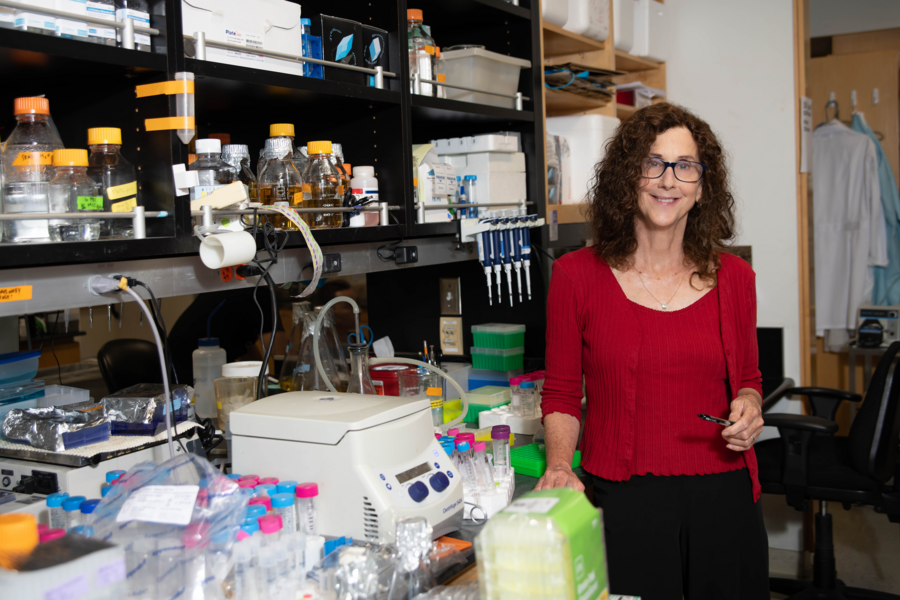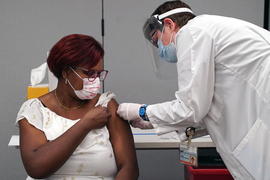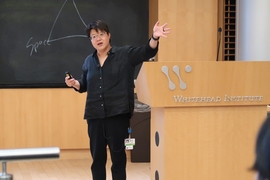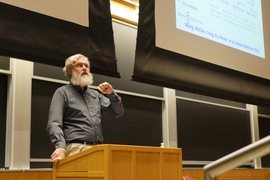Last month, the world welcomed the rollout of vaccines that may finally curb the Covid-19 pandemic. Pamela Björkman, the David Baltimore Professor of Biology and Bioengineering at Caltech, wants to understand how antibodies like the ones elicited by these vaccines target the SARS-CoV-2 virus that causes Covid-19. She hopes this understanding will guide treatment strategies and help design vaccines against future pandemics. She shared her lab’s work during the MIT Department of Biology’s Independent Activities Period (IAP) seminar series, Immunity from Principles to Practice, on Jan. 12.
“Pamela is an amazing scientist, a strong advocate for women in science, and has a stellar history of studying the structural biology of virus-antibody interactions,” says Whitehead Institute for Biomedical Research Member Pulin Li, the Eugene Bell Career Development Professor of Tissue Engineering and one of the organizers of this year’s lecture series.
Immunology research often progresses from the lab bench to the clinic quickly, as was the case with Covid-19 vaccines, says Latham Family Career Development Professor of Biology and Whitehead Institute Member Sebastian Lourido, who organized the lecture series with Li. He and Li chose to focus this year’s seminar series on immunity because this field highlights the tie between basic molecular biology, which is a cornerstone of the Department of Biology, and practical applications.
“Pamela’s work is an excellent example of how fundamental discoveries can be intimately tied to real-world applications,” Lourido says.
Björkman’s lab has a long history of studying antibodies, which are protective proteins that the body generates in response to invading pathogens. Björkman focuses on neutralizing antibodies, which bind and jam up the molecular machines that let viruses reproduce in human cells. Last fall, the U.S. Food and Drug Administration (FDA) authorized a combination of two neutralizing antibodies, produced by the pharmaceutical company Regeneron, for emergency use in people with mild to moderate Covid-19. This remains one of the few treatments available for the disease.
Together with Michel Nussenzweig’s lab at The Rockefeller University, Börkman’s lab identified four categories of neutralizing antibodies that prevent a protein that decorates SARS-CoV-2’s surface, called the spike protein, from binding to a human protein called ACE2. Spike acts like the virus’s key, with ACE2 being the lock it has to open to enter human cells. Some of the antibodies that Björkman’s lab characterized bind to the tip of spike so that it can’t fit into ACE2, like sticking a wad of chewing gum on top of the virus’s key. Others block spike proteins from interacting with ACE2 by preventing them from altering their orientations. Understanding the variety of ways that neutralizing antibodies work will let scientists figure out how to combine them into maximally effective treatments.
Björkman isn’t satisfied with just designing treatments for this pandemic, however. “Coronavirus experts say this is going to keep happening,” she says. “We need to be prepared next time.”
To this end, Björkman’s lab has put pieces of spike-like proteins from multiple animal coronaviruses onto nanoparticles and injected them into mice. This made the mice generate antibodies against a mix of pathogens that are poised to jump into humans, suggesting that scientists could use this approach to create vaccines before pandemics occur. Importantly, the nanoparticles still work after they’re freeze-dried, meaning that companies could stockpile them, and that they could be shipped at room temperature.
Björkman’s talk was the second in the Immunity from Principles to Practice series, which was kicked off by Gabriel Victora from The Rockefeller University. Victora discussed how antibodies are produced in structures called germinal centers that are found in lymph nodes and the spleen.
Next in the series is Chris Garcia from Stanford University, who will speak on Jan. 19 about his lab’s work on engineering immune signaling molecules to maximize their potential to elicit therapeutic responses. To round out the series, Yasmine Belkaid from the National Institute of Allergy and Infectious Disease will speak on Jan. 26 about interactions between the gut microbiome and the pathogens we ingest. These talks complement a number of career development seminars that were organized by graduate students Fiona Aguilar, Alex Chan, Chris Giuliano, Alice Herneisen, Jimmy Ly, and Aditya Nair.









